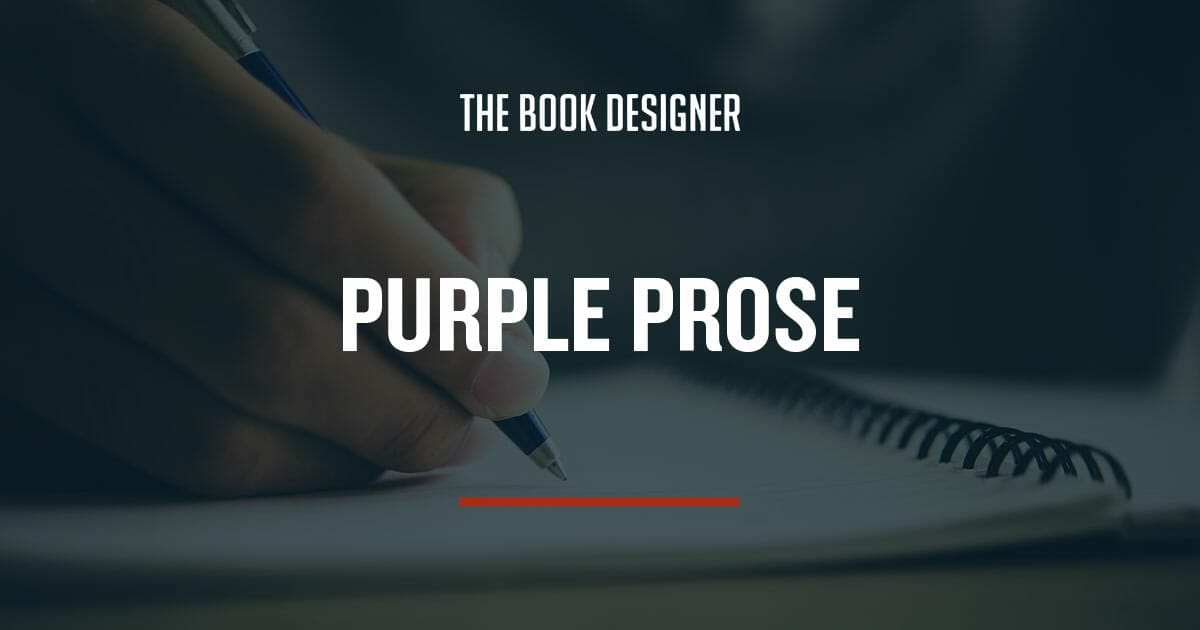When I say purple prose, what springs to mind?
Probably dense, complicated chunks of classic books you were forced to read in high school. Or maybe Twitter screenshots of embarrassing novels laden with straining metaphors. If anything, you probably know that it’s ‘bad’ and that we’re supposed to avoid it at all costs.
But what is it, really, and why should we avoid it? Are there instances where purple prose is good, actually? Let’s discuss how to identify purple prose and fix it when we run into it in our own writing.
What is Purple Prose?
Purple prose is prose that draws attention to itself rather than the subject matter. It does this by being excessively descriptive in a clumsy way. In a chunk of purple prose, you’ll see excessive adjectives, adverbs, and overly descriptive language that doesn’t do much to actually describe anything—all it really does is show itself off.
Purple prose is not the same as academic or descriptive writing. Often, people conflate purple prose with any writing that’s flowery, adjective-heavy, or dense—this isn’t totally fair. It’s possible to have a writing style that thrives in lush description and a more academic style. What makes purple prose distinct is its lack of finesse. Instead of using a lot of interesting adjectives to artfully weave a scene together, purple prose is tired and overly heavy.
So, to sum it up: purple prose is unnecessarily descriptive for the sake of being descriptive. This is not the same as having a flowery or adjective-heavy style, which is a perfectly valid way to write.

Is Purple Prose Bad?
As with every writing rule, it’s complicated.
Some of it comes down to taste. One reader might love more description-heavy scenes, and another reader might be a strict minimalist. Neither reader is wrong, and neither style is wrong–both styles can be done well or poorly. The issue isn’t with the style itself, but with its application.
A minimalist reader might consider adjective-heavy writing in general to be purple prose, and it can get subjective when we talk about what’s necessary to a story. Do we need all those adjectives? No, but anyone who loves more florid writing styles will say that the style itself lends to the overall tone—in other words, it’s part of the reading experience, so it’s vital.
All of that being said: if we stick with our definition of purple prose and say that it’s unnecessarily descriptive writing, then yes, purple prose is something we ought to avoid. In general, it’s best to convey information as efficiently as possible to the reader. We should absolutely use descriptions as a way to do that, but we want to keep our reader’s focus on the story, not on our authorial decisions.
How to Identify Purple Prose
If you’re an author who prefers a more descriptive style, how can you tell if you’re working with purple prose? It’s definitely not necessarily to convert to minimalism—again, style matters to any story—but it’s important to make sure you’re keeping your descriptions appropriate and succinct. Here’s how to assess your own work:
1. Get a writing buddy
If possible, enlist the help of a friend, and preferably an honest one. Have them read your work–it could just be a sample of it–and ask them whether they thought the descriptions were too much. Did they find the writing confusing? If so, why?
If your friends tell you that the descriptions were too long, the prose felt sluggish, or it was confusing, you might be dealing with purple prose.
2. Assess your adjectives honestly
If you can’t get a friend to read over your work, you can check it out for yourself! Go through your writing and highlight your adjectives. Purple prose isn’t exclusively an overreliance on adjectives, but if you’re seeing a ton of descriptions for everything, it’s a pretty good indicator that you’ve got some purple prose.
How to Fix Purple Prose
If you’ve discovered that your prose is, indeed, looking a little purple, don’t despair! There are a few things you can do to clean it up.
1. Decide What Needs Describing
Purple prose draws attention away from the story by over-describing everything. The fix here is simple: don’t do that!
Look at each scene individually. What’s important about that scene? Who are the most important characters, objects, and places? What would your POV character notice, and what would they filter out?
Go through your scene with a more critical eye and pick out these important pieces. These are the things you should focus on describing–everything else can be kept more low-key.
2. Pick a Key Attribute
Once you’ve picked out what in your scene needs to be described, you have to decide how to describe it. We want to avoid clunky, excessive adjectives, but we also want to get across how important this is.
We’ll do this by picking the most important thing about that object, person, or setting, and describing that. For example: a person has a thousand different descriptors. Hair color, eye color, clothing, stance, facial expressions, etc. all play a role in describing that person. However, we can’t reasonably list them all. What’s important about that character in that moment? Maybe they’re angry, so we describe their facial features.
Pick strong adjectives over multiple weak adjectives and strong verbs over and adverb + weak verb combo. This takes some trial and error, but once you get a hang of it, your descriptions will get shorter and more precise.
Examples of Purple Prose
Let’s go over some examples of purple prose to practice fixing it up.
PURPLE: Vanessa cheerfully batted her mile-long eyelashes and tossed her cascading brown hair over her shoulder, giggling as she ceremoniously considered the fascinating letter which had been mysteriously placed in her bright locker, bedazzled haphazardly with boy band stickers.
What works: We know what Vanessa looks like from this description, which is good, and we know she’s giggling, which means the mood is light. This is good information. The detail about her locker is also interesting.
What doesn’t: Too many adjectives and adverbs bog this passage down, making it difficult to read. We also have some cliche phrasing with ‘cascading brown hair’ and ‘mile-long lashes.’
FIXED: Vanessa batted her long lashes and tossed her brown hair, giggling as she considered the mysterious letter tucked behind a One Direction sticker on her locker.
PURPLE: The illuminating sunrise rose with a flourish over the incandescent waters, casting a semisweet pink and purple glow on the beach-goers who traipsed the shores with muddy sandals or wrinkled bare feet. A whimsical child carefully piled dripping sand into a crummy plastic sand-castle mold whilst his younger sister toddled to the ocean.
What works: ‘Semi-sweet,’ ‘traipsed,’ and ‘toddled’ are all strong verbs. I also like the detail about the crummy plastic sand-castle mold.
What doesn’t: Again, just a few too many adjectives. We could pick either the sunrise or the water to describe—we don’t need both—and we could focus more on those strong verbs and adjectives.
FIXED: The sunrise cast a semi-sweet glow on the beach goers traipsing the shores. A boy piled sand into a crusty sand-castle mold while his sister toddled to the ocean.
PURPLE: In a shocking moment of consideration, Emilia clutched the phone to her fluttering chest. Her mind did somersaults of confused pain as she considered the impossible dilemma set before her, so complicated and so impossible that she thought she might languish in despair for the remainder of her unfortunate, miserable days. With great hesitation and fear, she dialed the number which she so sincerely dreaded dialing, and much to her immeasurable displeasure, the other person answered.
What works: We do have a strong tone here, and there’s a cool style buried somewhere under all those adjectives. I like the verbs ‘clutched’ and ‘languished’—we have some potential here. I even like ‘fluttering chest,’ despite it bordering on cliche (tragically, there just aren’t a lot of ways to describe a pounding heart that aren’t a little trite).
What doesn’t: There’s a lot of weak verbiage and adjectives getting in the way. ‘Somersaults of confused pain’ and ‘in a shocking moment of consideration’ doesn’t make a lot of sense, and ‘impossible dilemma’ is sort of redundant. Most of this passage is completely vestigial and doesn’t add much information.
FIXED: Emilia clutched the phone to her fluttering chest while she considered her dilemma. Finally, she dialed, dreading each moment until the other person answered.
(A note: ‘languish’ was a strong verb here, but I couldn’t find a natural way to work it in, so I cut it. If you can find a way to keep those strong verbs, awesome! If not, it’s best to let them go. Write them down and save them for a later scene.)
Ready to write?
Get access to writing resources like our:
- Fiction Writing Video Training
- 300+ Strong Verbs List (a great resource for moments like these – when you’re tired of using penny and nickel words – but need to dial back on those $2 bill words)
- and access to our Better Writing Course
- and more, inside the Advanced Publishing Kit!




